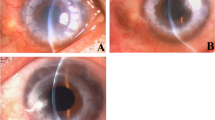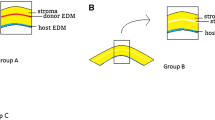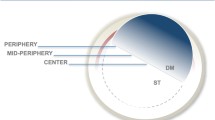Abstract
Clinical observation and cytological study of a successful “through and through” type of Cordona keratoprosthesis, which was removed along with a corneal button about 20 years after its implantation in an aphakic eye, revealed an acellular epitheliumlike film on its outer surface, firm anchoring of its supporting skirt by stable fibrous connections to the stroma, and a continuous separating membrane composed of a homogeneous proteinaceous film with fibroblastlike cells of macrophage origin on its inner surface. The significance of the successful adaptation of the plastic materials of the prosthesis to the tissues of the cornea and the fluid of the inner eye for the future of tissue engineering is discussed.
Similar content being viewed by others
References
Aquavella JV, Rao GN, Brown AC, Harris JK (1982) Keratoprosthesis. Results, complications, and management. Ophthalmology 89: 655–660
Barnham JJ, Roper-Hall MJ (1983) Keratoprosthesis: a long term review. Br J Ophthalmol 67: 468–474
Cordona H (1962) Keratoprosthesis, acrylic optical cylinder with supporting interlamellar plate. Am J Ophthalmol 54: 284–294
Cordona H (1969) Mushroom transcorneal keratoprosthesis (nut and bolt). Am J Ophthalmol 68: 604–612
Cordona H, Castroviejo R, De Voe GA (1962) The Cordona keratoprostesis: flirt clinical evaluation. XIX Concilium Ophthalmol 11: 1211–1229
Green WR (1984) Discussion paper #10.1984 Meeting, Am Ophthalmol Soc
Rizzuti AB (1983) Corneal damage: keratoprosthesis considered final opportunity for restored vision. Ophthalmol Times 8: 1 and 53
Wolter JR (1982a) Lens implant cytology. Ophthalmic Surg 13: 939–942
Wolter JR (1982b) Cell life on the surface of lens implants. Graefe's Arch Clin Exp Ophthalmol 218: 244–249
Wolter JR (1983a) Morphology of the capsule-like portion of the reactive membranes on intraocular lens implants. Graefe's Arch Clin Exp Ophthalmol 220: 58–65
Wolter JR (1983b) Fusion of macrophages on lens implants resulting in the formation of giant cells. Graefe's Arch Clin Exp Ophthalmol 221: 1–7
Wolter JR (1984) Cytopathology of intraocular lens implantation. Ophthalmology (in press)
Wolter JR, Lichter PR (1983) Fibroblast-like cells on intraocular lens implants phagocytosing erythrocytes. Br J Ophthalmol 67: 641–645
Wolter JR, Sugar (1984) Reactive cellular membrane on a piece of glass: removed after two years in the anterior chamber. Am Intra-Ocular Implant Soc J (in press)
Author information
Authors and Affiliations
Additional information
Supported by The Research To Prevent Blindness, Inc., New York, NY; Presented on May 22, 1984, at the 120th Meeting of the American Ophthalmological Society in Dorado, Puerto Rico
Rights and permissions
About this article
Cite this article
Wolter, J.R., Meyer, R.F. Sessile macrophages forming clear endotheliumlike membrane on the inside of successful keratoprosthesis. Graefe's Arch Clin Exp Ophthalmol 222, 109–117 (1985). https://doi.org/10.1007/BF02173533
Received:
Issue Date:
DOI: https://doi.org/10.1007/BF02173533




